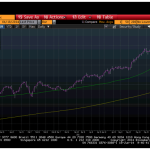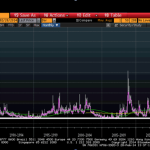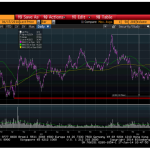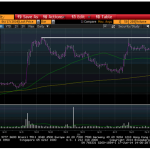Todd Harrison: Stock Market Observations From The Front | Random …

Editor’s Note: Todd posts his vibes in real time each day on our Buzz & Banter where subscribers can follow over 30 professional traders as they share their ideas in real time. Want access to the Buzz plus unlimited market commentary? Click here to learn more about MVPRO.
I find I’m so excited that I can barely sit still or hold a thought in my head. I think it’s the excitement only a free man can feel. A free man at a start of a long journey whose conclusion is uncertain. I hope I can make it across the border. I hope to see my friend and shake his hand. I hope the Pacific is as blue as it has been in my dreams. I hope.
— Ellis Boy “Red” Redding, Shawshank Redemption
It’s a beautiful Wednesday morning on the East Coast with temperatures tickling 80 degrees. It is also my wife’s birthday, and I would be remiss if I didn’t take a moment to recognize her awesomeness. I out-kicked my coverage with her, and she has brought my dreams to life; happy birthday Jamie, and thank you for all you do.
Tape-wise, the Little Engine That Could keeps on going, seemingly with its eye on the prize (S&P (INDEXSP:.INX) 1975). While we wrote last week about capitulation in the bear camp and the comeuppance that nobody sees coming, the seemingly endless cycle of “bad news is no news, no news is good news, and good news is great news” continues to continue.
I can’t help shake the image of Fannie Mae hugging the $70 strike for what seemed like years on end, and once I finally moved it to my restricted list, locking in multiple sixes with a crimson hue, the stock began its beeline to $0.70. Yes, the trading gods have a vicious sense of humor; the path of maximum frustration indeed.
So, what’s shakin,’ bacon? A lot, as we fire up this pup for Hump Day. Some top-line vibes, in no particular order:
Argentina is planning a debt swap, which triggered a short squeeze in the Merval. The index rallied about 7% overnight, recovering about 7% of the 17% it has lost since June 10.
We flagged GW Pharma (NASDAQ:GWPH) yesterday as the moon shot to all-time highs took place. It filed an offering after the close, taking advantage of the 947% rally since last summer — not a shocker; actually pretty smart — and the stock is off 5% as it digests a bit.
A friend of mine let me know how upset he was to sell GW Pharma on yesterday’s open. I told him to never bemoan a profitable trade as that will usher in the wrath of the trading gods.
In the interest of full disclosure, we’re still in discovery phase surrounding our strategic pivot. It has to be the right opportunity with the right team for it to make sense. I remain confident that as one door closes (digital media), another will open, and that will show itself in kind.
The VXO (INDEXCBOE:VXO) is back at a 10-handle and you know what that means.
Do I think we’ll see any meaningful reform surrounding high-frequency trading? No. Why? Follow the money.
I do believe we’ll look back at NYSE selling to ICE as a savvy move by the former NYX executives. I knew many of the top brass there — the definition of smart money.
I’m surprised LinkedIn (NYSE:LNKD) hasn’t branded an employment index based on its data.
Deutsche Bank (NYSE:DB) is quietly down 30% from its mid-January high and approaching last year’s low. There was a time that this would be quite telling; it remains to be seen if that time is now.
It’s tough to fade (read: sell) Twitter (NYSE:TWTR) while the World Cup is jacking usage.
Note the technical level in Keurig Green Mountain (NASDAQ:GMCR). One to watch.
Please remember that boredom isn’t an actionable catalyst; and while I’ve got you, here are 19 more rules of the road.
Lest you missed them, here are 12 cognitive biases that endanger investors:
1. Confirmation Bias
This is a fatal flaw of trading; we tend to surround ourselves with information that validates our own point of view and dismiss input that conflicts with our reasoning (also known as cognitive dissonance). This is the primary reason why we always strive to see “both sides of every trade” as the residual grist between variant views is where education — and profitability — resides.
2. In-Group Bias
This is a manifestation of confirmation bias, or the tendency to surround ourselves with those who share similar takes on the tape. This could pertain to our physical environment or a virtual experience, such as Twitter. Not only does this provide a false sense of security in our individual viewpoints, it makes us suspicious — or angry — with outsiders who dare to question how we feel. (See also: The Gold Scold.)
3. Gambler’s Fallacy
One of the most famous disclaimers in finance is that past performance is no guarantee of future results. This bias is often referred to as a “glitch” in our thinking in that it extrapolates what happened in the past to construct an idea of what will happen the future. How many of you have played roulette at a casino under the premise that a string of red increases the likelihood of a black outcome? That’s flawed thinking; the odds of red (or black, for that matter) are 48% on each independent spin.
4. Post-Purchase Rationalization
One of our Ten Trading Commandments is that the definition of an investment should never be a trade gone awry. Nobody initiates market exposure expecting to lose money, but we should never post-rationalize our risk (such as ignoring stop-losses or throwing good money after bad). We would be wise to remember that good traders know how to make money but great traders know how to take a loss.
5. Neglecting Probability
History is littered with stretches where in hindsight we’re reminded not to confuse brains with a bull market. This bias limits our ability to properly assess risk, whether it’s overstating an unlikely event (such as buying a stock for a takeover) or understating an unlikely event (such as Y2K, the fiscal cliff, or a terrorist attack). Tail events do happen, of course, but betting on an outlier is a long shot by its very definition.
6. Observational Selection Bias
This is when we suddenly notice something we haven’t noticed before, and wrongly assume the frequency has increased (when it hasn’t). Let’s say I bought cannabis stocks as a way to play (what I perceive to be) the legalization of marijuana. All of a sudden, everywhere I look, there are more and more signs that support my thesis; the topic is featured on 60 Minutes, it’s a hot-button issue during the election, it gained momentum in the mainstream media. While some of that may prove true, I am on the lookout for news, whether it’s conscious or not.
7. Status-Quo Bias
Most of us are creatures of habit in our own way; we use the same toothpaste or align with a particular smartphone device. That routine often extends to our investments in the marketplace; we’re comfortable with the stocks (or indices) we often trade and often miss opportunities outside of that comfort zone for fear of the unknown. Change isn’t only positive, it’s inevitable.
8. Negativity Bias
Let’s face it: We live in a sensationalist society where scare tactics and negative headlines garner the most attention. If you doubt this for a minute, turn on your local news tonight. Scientists theorize that we perceive negative news to be more important than positive news. The risk — for the bears and for humans as a whole — is the tendency to dwell on bad news rather than embrace good news, and there’s the added twist that the stock market is widely considered to be a leading indicator.
9. Bandwagon Effect
How prevalent is this when it comes to the financial markets? They teach it in college as a stylistic approach (momentum investing)! Nobody in our business — or in the media — wants to miss a move in the stock market, and history is littered with bubbles and busts that demonstrate this bias in kind. In life, this is driven by our innate desire to “fit in and conform”; in the markets, it’s driven by two factors: fear and greed.
10. Projection Bias
This is predicated on projecting our thoughts and beliefs onto others and assuming that others are wired the same way (they’re not). This can lead to “false consensus bias,” which not only assumes that other people think like we do, but that they reach the same conclusions. In short, this creates a false consensus, or sense of confidence when in fact one doesn’t, or shouldn’t, exist.
11. The Current Moment Bias
This is a direct descendent of the immediate gratification mindset that dominated society for many years — and some will argue that the government is currently operating in this mode, mortgaging our children’s standard of living to achieve short-term fixes. In short, we want to live as well as possible and pay for it at a later date (as evidenced by the level of debt and our growing deficit). The housing crisis was rooted in this bias, as is the basic concept of leverage.
12. Anchoring Effect
This tendency, also known as the relativity trap, compares a situation to a limited sub-set of information; it’s when we focus on a number or value and extrapolate it to a current situation. This often manifests in the marketplace through the fundamental metric, when we observe that a stock is “cheap” relative to its peers or a historical precedent (also known as a “value trap”).
Funny thing is, I used to ask this question when interviewing college kids on behalf of Morgan Stanely (NYSE:MS). I presume that the royalty check is in the mail.
R.P.
Twitter: @todd_harrison
Follow Todd and over 30 professional traders as they share their ideas in real time with a FREE 14 day trial to Buzz & Banter.
Position in TWTR
Click Here to read the disclaimer >
Todd Harrison is the founder and Chief Executive Officer of Minyanville. Prior to his current role, Mr. Harrison was President and head trader at a $400 million dollar New York-based hedge fund. Todd welcomes your comments and/or feedback at [email protected].
The information on this website solely reflects the analysis of or opinion about the performance of securities and financial markets by the writers whose articles appear on the site. The views expressed by the writers are not necessarily the views of Minyanville Media, Inc. or members of its management. Nothing contained on the website is intended to constitute a recommendation or advice addressed to an individual investor or category of investors to purchase, sell or hold any security, or to take any action with respect to the prospective movement of the securities markets or to solicit the purchase or sale of any security. Any investment decisions must be made by the reader either individually or in consultation with his or her investment professional. Minyanville writers and staff may trade or hold positions in securities that are discussed in articles appearing on the website. Writers of articles are required to disclose whether they have a position in any stock or fund discussed in an article, but are not permitted to disclose the size or direction of the position. Nothing on this website is intended to solicit business of any kind for a writer’s business or fund. Minyanville management and staff as well as contributing writers will not respond to emails or other communications requesting investment advice.
Copyright 2011 Minyanville Media, Inc. All Rights Reserved.
Link:
Todd Harrison: Stock Market Observations From The Front | Random …
See which stocks are being affected by Social Media





